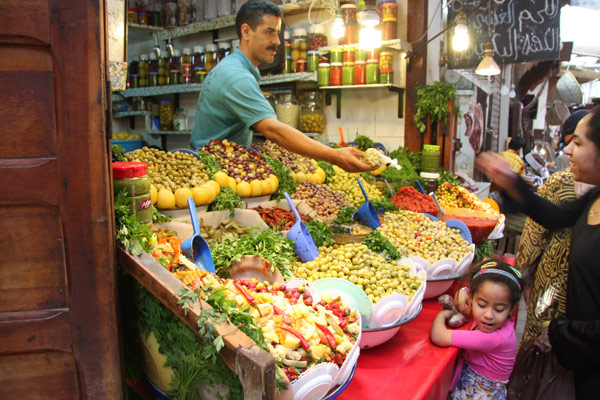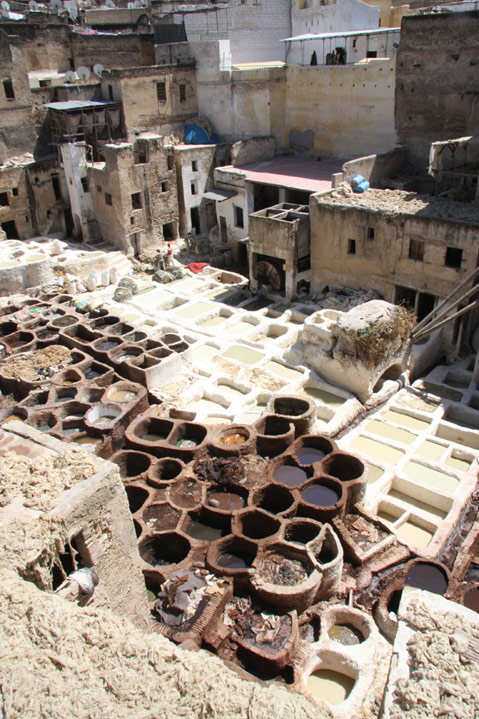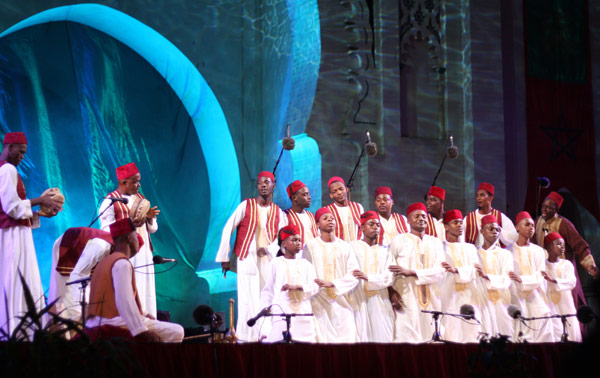Fes World Sacred Music Festival
Planned and Unplanned Arrivals, on Fes Time

In keeping with the half-mad Moroccan driving m.o., our taxi driver careened and caromed up the twisting road up to the Meredin Tombs, high up above the magical city of Fes. Well into our week-long Fes adventure, we wanted to get a bird’s eye vantage of the concentrated, beehive-like intensity of the ancient city herself, to get some long-distance perspective, and had been told this was the place for it. Along the way, he pointed out the palace, the old Borj Nord fortress (now an arms museum) and one of the world’s oldest universities, dropping us off in the peaceful hilltop site.
Once up amongst the ruins, inhabited by a few, lone grazing donkeys, we could see the sweep of the Fes al Bali, with minarets and mosques dotting the labyrinth far below, and hear the faint but clear, signature sound of the early afternoon “call to prayer.” It was a memorable moment of calm, before descending back down to the Bab Guissa and plunging back into the thrumming thicket of the Medina, and the pace of Fes life in progress.

When traveling in another country, especially an other country such as Morocco, one can expect multiple moments of that certain Sense of Arrival. Those are the moments when you know the old reality has been left behind, and that you have come across the desirable encounter with an entirely new world of sensations and ways of being far from the hum of home. These are the moments which hook you into the wanderlust-y allure of traveling, a willful dislodging of bearings bidden by global curiosity.
Early in June, in Fes, an early, ground-level sense of arrival hit us on the taxi ride from the airport to the hotel, with all the crazed, logic-defying driving tactics and seat-beltless adrenaline rush we’d read about. But the most profound arrivals came by way of the magical Fes al Bali, aka the Medina, and the enchanting matrix of sounds from Fes’ rightfully renowned, and 16th annual World Sacred Music festival, our primary reason for making this trek. But the secondary powerful sensations in and around this remarkable spot on the earth left memories which don’t seem to subside willingly.
In the quite useful and also dangerously temptation-dangling tome 1,000 Places to See Before You Die (which incidentally, includes the Santa Barbara Mission), the Moroccan section understandably opens with a prominent double-header—Fes al Bali and the World Sacred Music festival. The latter, set in a locale ideally centered between Europe, sub-Saharan Africa, the Middle and Far East, and the Americas, is something to behold for any world music lover. Heeding the idealistic notion that music can move freely across borders and even broker a kind of peace otherwise hard to find in the realm of political and ideological conflicts, the festival maintains a purposefully broad stylistic, cultural and “sacred” focus.

This year’s typically rangy festival roamed the world, from the Sufi Group Mtendeni Maulid of Zanzibar to the bracing Master Drummers of Burundi, from the mesmeric Parvathy Baul, out of the exotic Bengali Baul tradition to Jordi Savall’s new and ambitious, religion-crossing and peace-seeking—and overlong—concept piece Jerusalem, the City of Two Peaces: Heavenly Peace and Peace on Earth. The American contingent included, naturally enough, the iconic gospel group Blind Boys of Alabama and free-leaning saxophonists David Murray and Archie Shepp. Ben Harper, the token pop rep in the mix, was a no-show, citing a skateboarding accident: his evening slot was given over to the Saturday night Mali-an double-header with sinuous guitarist Djelimaday Tounkara and the popular, groove-machined African sensation, Amadou and Mariam.
Other 2010 highlights included music based on texts by sacred poets. Rumi’s words were set in the music of great Iranian singer Shahram Nazeri, joined by setar-playing son Hafez Nazeri and the Ensemble Rumi, and poems of Arab poet Hussein Mansour al-Hallaj (857-922) were at the center of an engaging contemporary classical project, “Prohibited Voices,” composed by Moroccan-born French resident Ahmed Essyad and delivered, sharply, by the French contemporary music-geared l’ensemble Accroche Note (Hang Note Ensemble).
Unlike more tourist-expressed cities such as Marrakesh and Tangier, Fes is the fascinating, antiquated, contradictory and spiritually-entrenched heart of Morocco. Broken up into the central Fes al Bali (the largest medieval city in the Arab world), the French-built Ville Nouvelle and the Fes el Djedid, Fes bustles with a unique old-warily-meets-new energy, more than most places in the known world.
Seeing, traipsing through, smelling and bartering is believing in this tangled maze-like and auto-free city (created almost a Millennium ago, long before auto culture changed city planning). Countless vendors in the labyrinth sell colorfully-arranged wares, slabs of fresh meat, tajines (the Moroccan dish—as in object and cuisine), and resident garb, including the robe-like djellabas and sumptuous leather slippers, babouches. You can buy a genuine fez in Fes, its birthplace, and stop to soak in the crackly ancient/quotidian sound of the muezzins’ Islamic “call to prayer,” the adhān, ringing out over the city five times a day. Legions of the devout arrange their days around prayers, slipping into the many mosques around Fes.

Getting lost in the Medina is an important and humbling rite of passage. On our first easy day, navigating the friendlier and tourist-inclined quadrant of the Medina, we idly meandered and photographed and haggled over merchandise and lunched on the Fassi delicacy of Pastilla (“pigeon pie”) and a chicken tajine while being serenaded by roving Gnawan musicians near the Bab Boujloud. On Day Two, the going got iffier in the Medina, around the Bab e R‘cif. Maybe our first mistake was asking directions to the beloved Kairaouine mosque, a cloistered power spot in Fes—and beyond in the Islamic world—nestled deep inside the Medina and off limits to non-Muslims.
For western outsiders lured to Morocco—some returning repeatedly or even settling here—the patron secular saint may be expatriate writer Paul Bowles, who most literally articulated the double dose of alienation and entrancement surrounding this place. In his novel based in Fes, The Spider’s House, he describes an experience of his character being dizzily led, in snaky patterns, through the Medina by a guide: “It delighted him that this anonymous, barefoot Berber should want to guide him through the darkest, least frequented tunnels of the city; the reason for the man’s desire for secrecy did not matter. These were a feline, nocturnal people. It was no accident that Fez was a city without dogs.”
You do notice the abundance of ownerless, emaciated cats roaming through the Medina, angling for scraps, keeping silent watch, sipping from the fountain in the middle of the Medersa Bou Inania as tourists (us, included) eagerly jump on the photo op. In fact, it was in the tranquil, enclosed sanctuary of the Bou Inania—the only Islamic holy place open to non-Muslims in Fes– that we got the truest sense of a time-suspending oasis of calm amid the crazed hurly burly of the secular Medina, and, by extension, the greater world outside.

Morocco is one of those Islamic nations which can be a startling encounter for someone accustomed to a more secularly-inclined environment, such as the crass, incurably materialistic and commercialized landscape of America. Dipping into a place where worship and appeals to Allah are woven into the fabric of daily life can be almost startling—and in some way intoxicating. If a centralized conservatism and aura of religiosity pervades the air and daily doings here, so do powerful whiffs of sensuality, sensed in such ways as the Moroccans’ deep love of music.
While the main, ticketed events of the Fes festival took place on the peaceful grounds outdoors at the Musée Batha in the afternoon and in the vast fortress-like Bab Al Makina by night, free-to-the-public concerts drew swarming, happy, olive-eating crowds of locals—including ever- present young children in tow, even in the wee hours–on the fringes of the festival machinery. Following the conventional profane-meets-sacred paradox woven throughout much of life here, crowds danced and jostled (and even quasi-“moshed”) at rhythmically seductive shows in the huge field venue of the Aäit Skato. They moved to a much more spiritualized, trance-making groove with the late-night Sufi shows at the Dar Tazi, often spilling past midnight and routinely achieving the desired state of transcending standard, secular human definitions of time.
It behooves anyone visiting Fes to plunge deeper into regional history and make a day trip to the ancient Roman ruins of Volubilis and the small holy city of Moulay Idris. In a few hours, on city sites looking out over a fertile valley, you traverse a vast swath of history and culture, from the Southernmost outpost of the Roman Empire around the time of Christ to a citadel almost a thousand years later, soon after the time of Mohammed.
We boarded the train to Meknes (clean and punctual), zooming idly past tapestries of olive trees and soft brown land spans. From the Meknes train station, we got a bit lost (again), but made the transition from a petit taxi to a grand taxi (aka a Mercedes of uncertain mechanical condition, started only by monkeying under the hood). Destination: ancient history.
Moulay Idris is a humble but important thousand-year-old hillside town, one of several Islamic pilgrimage sites, and so named after the virtual founder of Morocco, a great-grandson of the Prophet Mohammed, whose tomb is now the palpable centerpiece of the town. A guide assigned himself to us, and offered to guide us up through the twining narrow streets to an apex in the town, with a panoramic view of the tomb and Mosque below and the spread of the verdant valley.
Our guide, Youssef, was excited to learn that we had the same name, and was a gracious host. He proved to be a fount of information on Islamic pilgrimage sites, of which his hometown is proudly one. As we navigated the spidery path up and down the streets, he gave a primer in Islam, speaking in the power of fives—five pillars of faith, five daily prayers, five pilgrimage sites. He also detailed the varying percentages of Sunnis and Shiites in different countries, Iraq’s being a particularly close and polarized balance, and Morocco being primarily Sunni. Youssef himself was, he told us, of both Berber and Arab heritage, allying him directly to Moulay Idris, who married a Berber woman and thus laid out a legacy of peaceful cross-cultural relations in Morocco.
Before leaving the town, I bought a pocket-sized Koran from a stall for 100 dirhams (roughly $1 U.S.), and the seller asked “are you a Moslem?,” perhaps half hopeful and half suspicious. “No,” I said, “but I have respect for all religions.” I wasn’t sure if my answer pacified him or stirred anti-westerner sentiment, and wariness about this spiritually undisciplined tourist before him.
On Day Six of the trip, another sensation of Arrival came unexpectedly, through a back door. Late at night in Fes, we piled into a newer petit taxi, commandeered a hipper younger driver, and the startling sound of American R&B/hip hop slapped us upside the head. After not hearing western music for several days and having happily drowned in other sounds from other worlds, the pulsating sound of American culture struck my ears as something dully familiar, vaguely decadent, and out-of-place here. I knew then that some transforming experience had colored my world, and that I had to get back here.
Morocco should be on any globally curious traveler’s wish list map. Politically, spiritually, socially, culturally and economically, it is a whole new world. The exoticism quotient is high, and the price index is low by our standards (i.e., $1.50 for a 15-minute “petit taxi” ride, $7 for a decent meal). As an Arab nation tucked just under southwestern Europe and with appurtenances of modern globalized life, Morocco is a great place to visit, and offers an illuminating view of Arab life.
More importantly, though, a geo-spiritual energy runs through it.



